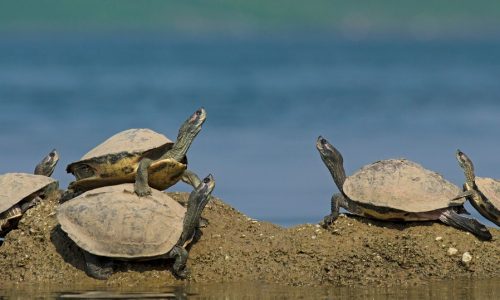CHITWAN NATIONAL PARK
Chitwan National Park is the first National Park of Nepal and has a rich cultural flora and fauna. It is the home to one of the last populations of single-horned Asiatic rhinoceros and is also one of the last refuges of the Bengal Tiger. The national park is tucked away at the foothills of the Himalayas in the Central Terai Region. It extends over the four districts of Chitwan, Nawalparsi, Parsa and Makwanpur. The ecosystem consists of the Siwaliks Range as well as the fertile alluvial flood plains. The Gandaki River which is the third largest river in Nepal runs through the national park acting as the lifeline of wildlife there and also as a scenic attraction to people.
The national park is also a home to two religious areas: Bikram Baba at Kasara and Balmiki Ashram in Tribeni. These places draw pilgrimages from nearby areas and across India. It is also the native home to the tribal community named “Tharu”, who have been residing here for centuries and are known for their interesting and exotic cultural practices. The forest is of moist deciduous type and Sal is the most predominant tree.
Chitwan National Park, a UNESCO World Heritage Site is rich in biodiversity. The park is resident to 31% of mammals, 61% of birds, 34% of amphibians and reptiles and 65% of fishes that are found in Nepal. The park has the largest concentration of birds (about 350 species) making it the hotspot for ornithologist. It was recognised as one of the world’s diversity hot spots by Conservation International and it falls amongst WWF’s 200 Global Eco – regions.
| Location |
Chitwan, Nawalparasi, Parsa and Makwanpur Districts (Nepal) |
|---|
| Nearest Airport |
Bharatpur airport – 15 Km to the Chitwan National Park. Buddha Air and Yeti Airlines have daily flights to Bharatpur from Kathmandu. |
| Nearest Bus Stand |
From Kathmandu: First bus leaves at 07:00 am from Thamel along Kantipath Road and it takes 5 to 7 hours. You can also take local or private air con buses operated by Greenline Tours. |
|
From Pokhara: The tourist buses from Pokhara bus stop leave at 07:30 am. Travel time is approx. 5 to 7 hours. The last stop is the Bachhauli tourist bus park, a 15 mins walking distance from Sauraha. Jeeps can be hired for the last leg of the journey. Beware of touts, as it is better to book your transport from the hotel. |
| Key Wildlife Attractions |
Bengal Tiger, Clouded Leopard, One horned Rhinoceros, Bengal Foxes, Golden Jackals, Yellow throated Martens, Asian Palm Civets, Hispid Hares, Gharials. |
| Total Area Covered |
932 sq. kms. |
| Established in Year |
1973 |
| Vegetation |
Sub – tropical Moist deciduous forests with alluvial grasslands and marshlands. |
| Best Time to Visit |
The best time of the year to visit the Chitwan National Park is October to February. |
| Climate |
October – February: Has average temperature of 25°C and offers an enjoyable climate.. |
|
March – June: Temperature can reach as high as 43°C making it uncomfortable to go on safaris or trekking. |
|
June – September: Monsoons set in and the rivers get flooded. The weather is hot and sticky, and the rising water level makes the park inaccessible. |
CHITWAN NATIONAL PARK ACTIVITIES
Chitwan National Park is a paradise for wildlife enthusiasts and has got multiple activities to offer. There are many half, full or muti-day adventure activities to choose from as mentioned below. We would recommend you book the preferred activities ahead of your proposed trip so the required permits can be taken, and camping gears, food and transport arrangements can be done.
| Activity |
Duration |
Description |
|---|
| Jungle Walk/Trekking |
Half/Full/Multi Day |
A Jungle Walk/Trek is a great opportunity to observe the forest wildlife from close quarters at the Chitwan National Park. You will be accompanied by trained naturalists on this trip who will offer valuable insights into the flora and fauna of the jungle. Overnight treks that go deeper into the forest also include accommodation and packed lunch/dinner in some cases. |
| Jeep Safari |
Half/Full/Multi Day |
The Jeep Safari allows you to go deeper into the forest with short breaks at popular sighting spots. Two/three day tours offer better value with a mix of excursions and activities |
| Elephant Ride/Trek |
1-1.5 hrs |
An Elephant ride is probably the best way to see Rhinos at Chitwan. These rides can be hired from the lodges or local tour agencies, and are usually carried out two/three times in a day – morning and late afternoon. |
| Visit to Elephant Breeding Center |
3-4 hours |
The Elephant Breeding Center at Sauraha was established for captive breeding of domesticated elephants. A visit to this center will offer you insights into the life of elephants, their nature and habitats. Timings: 06 am – 06 pm |
| Elephant Bathing |
- |
You can walk down to the Rapti river late afternoon and see some mahouts bathing their elephants after a hard day's work. Take a ride over one of these mammals and enjoy the sun set. |
| Canoeing |
Half/Full Day |
Hire a canoe for a half/full day ride on the Rapti river looking out for Crocodiles and various wet-land species. Customised packages also include 1-2 hours of canoeing followed by short jungle walks. |






